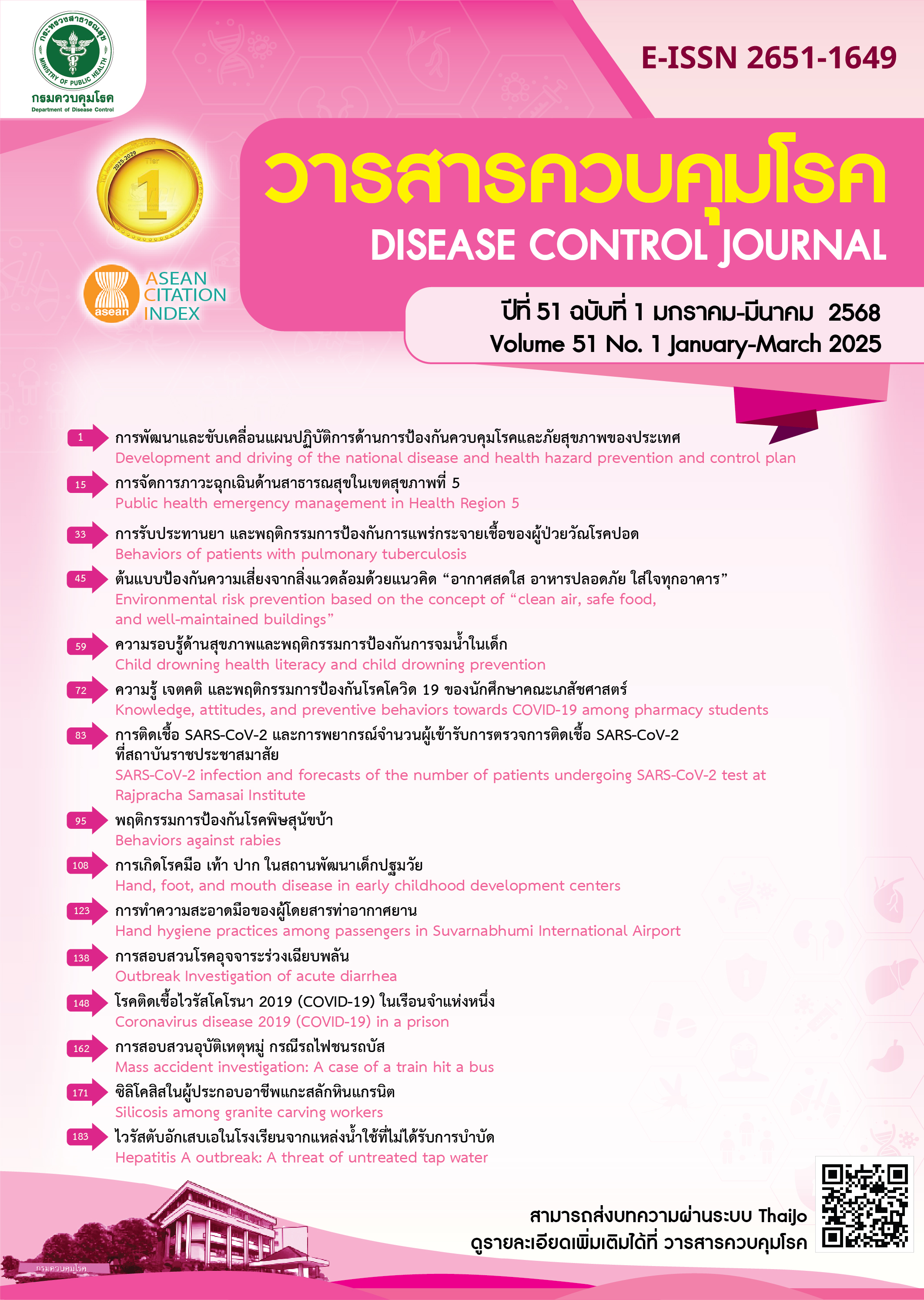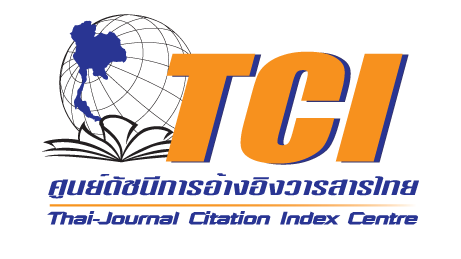Development of prototype schools for environmental risk prevention based on the concept of "clean air, safe food, and well-maintained buildings”
DOI:
https://doi.org/10.14456/dcj.2025.4Keywords:
school, PM2.5, asbestos, lead, pesticidesAbstract
This study aimed to develop prototype schools designed to prevent environmental pollutants, such as PM2.5, asbestos, lead, and pesticides, using a research and development approach. The study was divided into 4 phases: phase 1 situation analysis, assessing existing school initiatives to address environmental issues; phase 2 guideline development, developing operational protocols for target schools; phase 3 implementation, launching the guidelines in selected schools; and phase 4 evaluation, measuring outcomes and effectiveness. Data collection included focus group discussions, observations, and document reviews, using discussion guides and performance evaluation forms. Content analysis and descriptive statistics were employed for data analysis. In Phase 1, 29 participants from 23 schools participated online focus group discussions. Most schools reported engaging in farming activities, they highlighted knowledge gaps in lead and asbestos prevention. From Phase 2 to Phase 4, 6 key components for prototype schools and 4 measures for environmental pollution prevention were established based on 22 criteria. A total of 21 schools from across the country participated in the implementation phase, most of which were from kindergarten to lower secondary levels. An analysis of the implementation for each measure revealed that all schools completely implemented measures to prevent PM2.5. Measures to prevent asbestos and pesticide exposure were achieved by at least 19 schools, while measures to prevent lead contamination were adopted by at least 18 schools. Notably, innovative solutions were developed by 8 schools to enhance their preventive measures. The evaluation showed that all participating schools achieved over 70% compliance with the established measures. The Department of Disease Control, in collaboration with the Ministry of Education, is currently working to extend these initiatives to a wider range of schools.
Downloads
References
Wongchan W. Health promotion and prevention diseases of Particulate Matter PM2.5 in school-age children. Rama Med J. 2023;46(4):52-65. (in Thai)
Department of Diseases Control (TH). Notification of the Ministry of Public Health Re: Environmental Diseases and Symptoms No. 2 B.E. 2565 [Internet]. 2565 [cited 2023 Nov 20]. Available from:https://ddc.moph.go.th/uploads/files/14720220324053247.PDF (in Thai)
Ni R, Su H, Burnett RT, Guo Y, Cheng Y. Long-term exposure to PM2.5 has significant adverse effects on childhood and adult asthma: A global meta-analysis and health impact assessment. One Earth. 2024;7(11):1953-69.
Buranatreved S, Dumavibhat N. Asbestos: Health effect, Prevention and Policy Drive [Internet]. 2565 [cited 2024 Nov 24]. Available from: https://www.pcd.go.th/wp-content/uploads/2023/05/pcdnew-2023-05-26_03-41-31_ 692979.pdf (in Thai)
Campopiano A, Cannizzaro A, Olori A, Angelosanto F, Ramires D, Basili F, et al. Asbestos containing materials in schools of Rome and surrounding area (Italy). Ind Health. 2021;59(6):436-48.
U.S. Center for Disease Control and Prevention (U.S.CDC). Childhood Lead Poisoning Prevention: Risk Factors and Children [Internet]. 2024 [cited 2023 Nov 24]. Available from: https://www.cdc.gov/lead-prevention/risk-factors/children.html
Rawat PS, Singh S, Mahdi AA, Mehrotra S. Environmental lead exposure and its correlation with intelligence quotient level in children. J Trace Elem Med Biol. 2022;72:126981.
Pesticides, Children’s Environmental Health Collaborative, Children’s Environmental Health Collaborative. Pesticides [Internet]. 2020 [cited 2024 Nov 24]. Available from: https://ceh.unicef.org/spotlight-risk/pesticides
Department of Labour Protection and Welfare (TH). Safety School Project [Internet]. 2024 [cited 2024 Nov 24]. Available from: https://osh.labour.go.th/index.php?option=com_content&view=article&id=3075 (in Thai)
Ministry of Education (TH). Announcement of the Ministry of Education related to PM2.5 prevention in the school [Internet]. 2023 [cited 2024 Nov 24]. Available from: https://www.moego.th/360preventive-measures-solve-pm25/ (in Thai)
Yarnwaidsakul K, Saetia W. Preventative model for lead exposure in children at child development centres based on community participation in the upper southern Thailand. Disease Control Journal. 2561;44(2):217-26. (in Thai)
Jitarsa of the Ministry of Education (TH). The "Civilized Agriculture Project: Preserving, Sustaining, and Advancing the Philosophy of Sufficiency Economy through “Khok Nong Na: A Land of Generosity and Hope.” [Internet]. 2023 [cited 2024 Oct 20]. Available from: https://jitarsa.moe.go.th/category/sep-to-sdgs/ (in Thai)
U.S. Environmental Protection Agency (U.S. EPA). Asbestos and School Buildings [Internet]. 2013 [cited 2024 Nov 24]. Available from: https://www.epa.gov/asbestos/asbestos-and-school-buildings
Puthomdee P. The development of process problem lead exposure in children at Ban Nonsawang Child Development Center Kamalasai District Kalasin Province. J Res and Health Inno Develop. 2021.2(2):23-35. (in Thai)
Downloads
Published
How to Cite
Issue
Section
License
Copyright (c) 2025 Disease Control Journal

This work is licensed under a Creative Commons Attribution-NonCommercial-NoDerivatives 4.0 International License.
Articles published in the Disease Control Journal are considered as academic work, research or analysis of the personal opinion of the authors, not the opinion of the Thailand Department of Disease Control or editorial team. The authors must be responsible for their articles.


.png)



